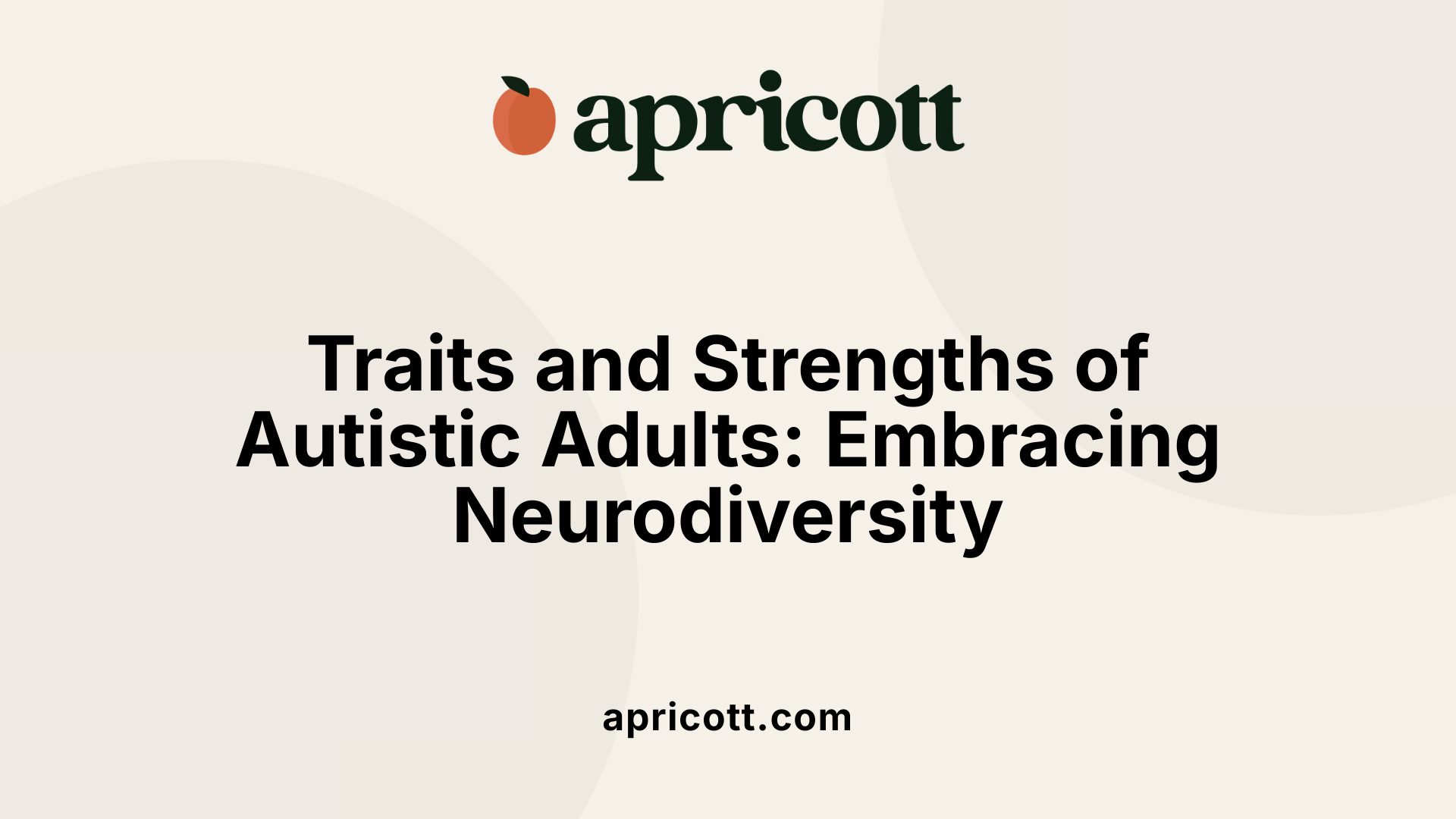Unveiling the Signs and Symptoms of Autism in Adults
Autism Spectrum Disorder (ASD) is often associated with children, but it significantly impacts adults as well. Recognizing the signs and understanding the associated traits can promote diagnosis, support, and better quality of life for adults on the spectrum. This article explores the core characteristics, detection methods, and available resources to deepen awareness about autism in adulthood.
Core Signs and Symptoms of Autism in Adults

What are the common signs and symptoms of autism in adults?
Many autistic adults exhibit a combination of social, behavioral, and sensory-related signs. They often struggle with social interactions, finding it difficult to interpret social cues, understand others' emotions, or respond appropriately in conversations. Consistent with this, limited eye contact and literal understanding of language, including trouble grasping sarcasm or idioms, are common.
Repetitive behaviors and routines play a significant role in daily life. These might include strict adherence to routines, intense interests in specific topics, and sensory sensitivities, such as hypersensitivity to sounds, lights, or textures. Many prefer solitude or find social situations overwhelming, which could lead to social withdrawal or appearing disinterested.
Additionally, many adults mask these symptoms through social camouflaging—adopting subtle behaviors like mimicking others' speech or avoiding eye contact—to blend in with their peers. This masking can be exhausting and may lead to feelings of isolation, anxiety, and depression.
Overall, autism in adults manifests uniquely in each person, but these signs can serve as useful indicators for understanding autistic traits.
How can autism be recognized or identified in adults?
Recognition of autism in adults involves observing persistent patterns of social, behavioral, and sensory challenges. Adults might find it hard to maintain conversations or interpret social cues like facial expressions or gestures. They may prefer to be alone, have narrow or intense interests, and rely heavily on routines, experiencing anxiety when these are disrupted.
Repetitive behaviors such as hand-flapping, rocking, or lining up objects are common, as are sensory sensitivities—such as discomfort from loud noises, bright lights, or certain textures—that prompt coping strategies like wearing noise-canceling headphones or engaging in stimming activities.
Many adults mask their symptoms to fit in, which involves imitating others' speech and gestures or making forced eye contact. This mask can obscure signs of autism, making diagnosis challenging. No single biological test exists; instead, a comprehensive assessment by healthcare professionals, including developmental history and behavioral evaluations, is necessary for accurate diagnosis and access to support.
What are the challenges and diagnostic criteria for diagnosing autism in adults?
Diagnosing autism in adults presents several challenges. Symptoms can be subtle or masked, especially in women who often learn to hide their signs more effectively, leading to underdiagnosis or misdiagnosis. Overlapping symptoms with other mental health conditions, such as social anxiety disorder or ADHD, complicate the diagnosis process.
According to the DSM-5, criteria for autism involve persistent deficits in social communication and interaction across various contexts, such as difficulty with social-emotional reciprocity, nonverbal communication, and developing or maintaining relationships. Restricted and repetitive behaviors like strict routines, fixations, or sensory sensitivities are also part of the criteria.
Symptoms must have been present early in development, though they may be less obvious in adulthood due to masking or compensation. The diagnosis relies on tools like ADOS or RAADS-R, in addition to clinical judgment. Recognizing these signs enables adults to access tailored support, resources, and community connections.
Are there educational resources available to help understand autism signs and symptoms in adults?
Yes, a wide range of educational resources is accessible for those seeking to understand autism in adults. Various reputable organizations and online platforms offer guides, videos, and training modules tailored to autistic adults, their families, and healthcare providers.
These resources focus on increasing awareness of social challenges, sensory sensitivities, and behavioral patterns associated with autism. They also provide practical advice on daily living, employment, social participation, and mental health management.
Support networks and community programs further assist adults in navigating life with autism, offering peer support, social skills training, and occupational therapy options. Healthcare providers also utilize specialized assessments to identify autism, ensuring individuals receive appropriate support.
Understanding autism’s signs and symptoms in adults through such educational tools can empower individuals to seek diagnosis, embrace their strengths, and access necessary resources for a fulfilling life.
| Aspect | Details | Additional Notes |
|---|---|---|
| Social Interaction | Difficulty interpreting cues, limited eye contact, blunt responses | Challenges in forming relationships |
| Communication | Literal language understanding, delayed speech, nonverbal issues | Use of monotone, minimal facial expressions |
| Repetitive Behaviors | Routine adherence, hand-flapping, rocking, lining up objects | Can serve as self-soothing behaviors |
| Sensory Sensitivities | Hypersensitivity or hyposensitivity to sounds, lights, textures | Using coping mechanisms like noise-canceling headphones |
| Masking Strategies | Imitation, social camouflaging, forced eye contact | Masks symptoms but can lead to exhaustion |
| Diagnosis | Based on behavioral assessments, early childhood signs, developmental history | No definitive biological tests |
| Support Resources | Therapy, peer groups, education about autism, employment assistance | Available through various organizations |
By understanding these core areas, we can better recognize autism in adults and facilitate timely support and acceptance.
Traits and Characteristics Linked to Autism in Adults

What characteristics and traits are typically associated with autism spectrum disorder in adults?
Autism spectrum disorder (ASD) in adults involves a range of behaviors and traits that affect social interaction, communication, and behavior. Many autistic adults find it challenging to interpret others' thoughts and feelings, which can hinder forming and maintaining relationships. They often prefer routines and exhibit intense interests in specific topics, engaging in repetitive behaviors such as following strict schedules or tidying objects in particular ways. Sensory sensitivities are common; environments with bright lights, loud sounds, or certain textures can feel overwhelming.
Furthermore, adult autistics may display challenges in emotional regulation, sometimes reacting with frustration or anxiety. A notable characteristic, especially among women, is masking or camouflaging behaviors to hide their symptoms, including imitating social cues or suppressing repetitive movements. Difficulties with verbal and nonverbal communication—like maintaining eye contact, recognizing social cues, or understanding figurative language—are also prevalent. Many coexist with mental health conditions such as anxiety, depression, or ADHD, which can influence their social and emotional well-being.
| Characteristic/Behavior | Description | Additional Notes |
|---|---|---|
| Social communication challenges | Difficulty interpreting social cues, understanding others’ feelings, and maintaining conversations | Includes blunt responses or literal interpretation of language |
| Routine and interest patterns | Preference for predictable routines; intense interests in specific topics | Can lead to deep expertise but may limit social sharing |
| Sensory sensitivities | Over or under reactions to lights, sounds, textures, and smells | Might necessitate coping strategies like noise-canceling headphones |
| Masking behaviors | Imitating others’ speech or gestures, forced eye contact, hiding repetitive movements | Can cause exhaustion and emotional strain |
| Co-occurring mental health conditions | Anxiety, depression, ADHD | Often require concurrent treatment |
How do sensory sensitivities and emotional regulation issues manifest among autistic adults?
Many autistic adults experience heightened or diminished sensory responses. For example, they might find bright lights painfully intense or be overwhelmed by loud noises, leading them to seek quiet or dark environments. Some avoid specific textures or smells that trigger discomfort, while others may seek sensory input for comfort.
Emotionally, adults with autism can struggle to manage their feelings, resulting in stress, irritability, or mood swings. They might find it difficult to express emotions clearly, which may lead to misunderstandings. Emotional regulation techniques, including deep breathing exercises, sensory tools, and therapy, can help manage these difficulties.
In what ways do masking and camouflaging behaviors impact adults with autism?
Masking involves consciously or unconsciously hiding autistic traits to blend into social settings. Adults may mimic social behaviors they observe, suppress repetitive motions, or force eye contact to appear more typical. While masking may facilitate social interactions and reduce immediate misunderstanding, it is often exhausting. Over time, it can lead to feelings of identity loss, anxiety, depression, and social burnout.
Women are especially adept at masking, which sometimes results in delayed diagnosis or misdiagnosis because their outward presentation may seem more socially typical. Recognizing the prevalence and impact of masking highlights the need for supportive environments that celebrate authentic expression and reduce the pressure to conform.
What mental health conditions frequently co-occur with autism in adults?
Anxiety and depression are among the most common co-occurring conditions. Anxiety may stem from the difficulty interpreting social cues, sensory overload, or fears of social judgment. Symptoms include persistent worry, avoidance, and physical symptoms like sweating or rapid heartbeat.
Depression can develop from ongoing social isolation, difficulty expressing oneself, or frustration with everyday challenges. Additionally, many autistic adults exhibit traits of ADHD, such as impulsivity, inattention, or hyperactivity, which can further complicate daily functioning.
Integrated care approaches addressing both autism and co-occurring mental health issues are essential for improving quality of life.
| Aspect | Manifestation | Support Strategies |
|---|---|---|
| Sensory sensitivities | Overload or under-responsiveness | Sensory-friendly environments, coping tools |
| Emotional regulation | Mood swings, anxiety, frustration | Therapy, relaxation techniques |
| Masking behaviors | Camouflage of symptoms, exhaustion | Acceptance, supportive communities |
| Co-occurring conditions | Anxiety, depression, ADHD | Medication, counseling, social skills training |
Understanding these traits and challenges provides better insight into adult autism, promoting awareness, empathy, and tailored support for individuals navigating life on the spectrum.
Supporting Adults with Autism: Challenges and Resources

What are the challenges and diagnostic criteria for diagnosing autism in adults?
Diagnosing autism in adults can be complex due to several factors. Symptoms may be subtle or masked by coping strategies developed over time, making them harder to recognize. Additionally, many adults have learned to hide behaviors that were once obvious in childhood, a process known as masking. This can include adopting social mimicry, suppressing repetitive movements, or avoiding eye contact.
According to the DSM-5 (Diagnostic and Statistical Manual of Mental Disorders, Fifth Edition) criteria, an adult must demonstrate persistent difficulties in social communication and interaction across multiple settings. These include challenges with social-emotional reciprocity, understanding and responding to social cues, maintaining relationships, and nonverbal communication like eye contact or facial expressions.
Restricted and repetitive behaviors are also part of the diagnosis. Adults may engage in routines, have highly focused interests, or display sensory sensitivities such as hypersensitivity to sounds, lights, or textures.
Assessment for diagnosis often involves clinical tools such as the Autism Diagnostic Observation Schedule (ADOS) and the Ritvo Autism Asperger Diagnostic Scale-Revised (RAADS-R). Clinicians consider developmental history, current behavioral symptoms, and the impact on daily life.
One challenge in diagnosing adults is that some symptoms overlap with other mental health conditions like social anxiety or attention-deficit/hyperactivity disorder (ADHD). Moreover, the diagnosis requires that symptoms were present during early childhood, even if they were not recognized at the time.
Why is early diagnosis and intervention crucial for adults on the spectrum?
Early diagnosis provides a foundation for accessing targeted support, therapy, and understanding. When individuals recognize their autism early, they can develop strategies to manage sensory overload, social anxiety, and emotional regulation more effectively.
Interventions like speech therapy, social skills training, and occupational therapy can significantly improve communication abilities and daily functioning. Knowing their diagnosis helps adults understand the roots of their experiences, reducing feelings of confusion or shame.
Although many adults are diagnosed later in life, it is never too late to benefit from understanding and support. Early identification can help reduce mental health issues such as anxiety or depression that often accompany unrecognized autism.
What support options are available for autistic adults, and how do these improve daily life?
There are a variety of support mechanisms designed to improve the quality of life for autistic adults. Therapy options include cognitive-behavioral therapy (CBT) for co-occurring conditions like anxiety or depression, social skills groups, and emotional regulation programs.
Vocational support is vital for employment success. Workplace accommodations such as quiet workspaces or flexible schedules can help manage sensory sensitivities and executive functioning challenges like time management and organization.
Peer support groups and community programs foster social connections, combat isolation, and provide a sense of belonging. Many organizations also offer training on independence, daily living skills, and navigating social interactions.
Assistive technologies like noise-canceling headphones, organizational apps, and sensory-friendly tools help manage sensory overloads and improve daily functioning.
Living with autism involves unique strengths, including intense focus and strong memory. Support systems aim to maximize these strengths while providing tools to cope with daily challenges, ultimately leading to more fulfilling and independent lives.
| Aspect | Support Options | How They Help |
|---|---|---|
| Therapy | CBT, social skills training, occupational therapy | Manage emotional and social challenges |
| Employment support | Workplace accommodations, job coaching | Improve job retention and satisfaction |
| Peer and community groups | Support networks, social clubs | Reduce isolation, strengthen social skills |
| Assistive technologies | Noise-canceling headphones, apps for organization | Ease sensory sensitivities, improve daily routines |
Understanding and supporting adults with autism require awareness of their challenges and recognition of their strengths. With appropriate diagnosis and resources, many adults lead enriched, independent lives.
Living as an Autistic Adult: Insights and Perspectives

How does living with autism affect daily life, and what strategies can help?
Autistic adults often face daily challenges such as social discomfort, sensory overload, and difficulties adjusting to changes in routines. These experiences can make everyday activities more complex and sometimes overwhelming. To navigate these challenges, many adopt practical strategies that promote stability and well-being. One effective approach is creating structured daily schedules that provide predictability and reduce anxiety about the unknown. Using sensory tools like noise-canceling headphones, fidget devices, or textured objects can help manage sensory sensitivities. Mindfulness techniques—such as deep breathing or grounding exercises—are also beneficial for reducing stress. Understanding personal triggers is essential. By identifying specific stimuli or situations that cause overwhelm, autistic adults can develop tailored coping mechanisms, whether by modifying their environment or seeking support. Maintaining routines linked to their interests offers comfort and joy, while engaging in special interests can provide a sense of accomplishment and community. Enhancing communication skills through social skills training or therapy can improve interactions and build confidence. Overall, a self-aware approach that values individual needs and strengths helps adults navigate daily life with resilience and independence.
What role does self-awareness and acceptance play for autistic adults?
Self-awareness and acceptance are cornerstones for leading fulfilling lives as autistic adults. Recognizing one’s unique strengths, such as deep focus, strong memory, or talents in arts, science, or math, fosters confidence and personal growth. Being aware of sensory sensitivities and behavioral patterns allows individuals to tailor their environments and routines, reducing discomfort and enhancing comfort. Acceptance involves embracing neurodiversity—that differences in neurological functioning are natural and valuable. This mindset reduces shame and mental health struggles, helping adults seek support without fear of judgment. Connecting with supportive communities, both online and in person, reinforces positive identity and provides shared understanding. Embracing one's neurodivergent identity encourages a sense of pride and resilience. It also enhances social relationships by fostering authenticity and openness. Overall, self-awareness and acceptance empower autistic adults to navigate life authentically and build meaningful connections.
In what ways does social masking impact mental health, and how can adults find support?
Many autistic adults engage in masking—adopting behaviors like forced eye contact, imitating speech, or suppressing repetitive actions—to fit in socially. While this may temporarily ease social interactions, it is often mentally draining. Masking can lead to burnout, increased anxiety, depression, and feelings of disconnection from oneself. Over time, it may contribute to low self-esteem and social withdrawal, impacting overall mental health. Support strategies involve recognizing the signs of exhaustion from masking and seeking environments that validate neurodiverse identities. Engaging with understanding communities—whether through peer groups, online forums, or therapy—can offer acceptance and shared experiences. Therapies like neurodiversity-affirming counseling focus on reducing the need to mask while promoting self-understanding. Learning self-care practices, setting boundaries, and prioritizing authenticity are important steps. Building awareness about masking helps adults distinguish their true selves from behaviors adopted to gain social approval. Surrounding oneself with empathetic individuals and advocating for acceptance reduces the toll on mental health and promotes a more sustainable sense of well-being.
Additional Support and Considerations
| Aspect | Description | Support Strategies |
|---|---|---|
| Communication | Challenges interpreting social cues, facial expressions, or tone | Social skills training, communication aids |
| Sensory Issues | Discomfort or heightened sensitivity to stimuli | Sensory-friendly environments, coping tools |
| Routines & Interests | Dependence on routines, intense focus on specific topics | Structured routines, pursuit of interests |
| Emotional Regulation | Difficult managing fluctuating emotions | Mindfulness, emotional regulation therapy |
| Community & Support | Need for acceptance and understanding | Peer groups, advocacy organizations |
Understanding these diverse aspects helps in appreciating the full experience of living with autism in adulthood. Recognizing strengths and implementing supportive strategies foster a more inclusive society where autistic adults can thrive.
Moving Forward with Awareness and Support
Recognizing the diverse signs and traits of autism in adults is vital for fostering understanding, acceptance, and access to tailored resources. While diagnosis can be complex, the benefits of self-awareness and professional guidance are profound, enabling adults to navigate their lives with confidence. Embracing neurodiversity and expanding educational efforts helps build inclusive communities where autistic adults are supported and valued, ultimately enriching societal understanding of the autism spectrum.
.svg)
.svg)








